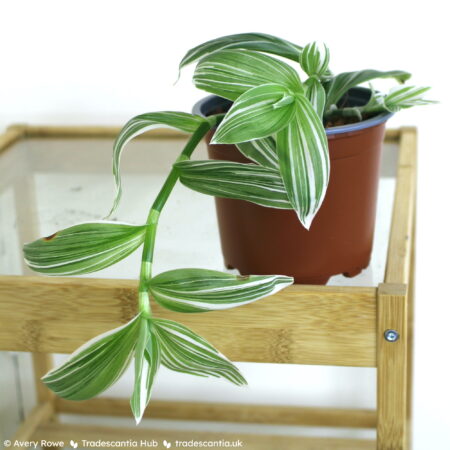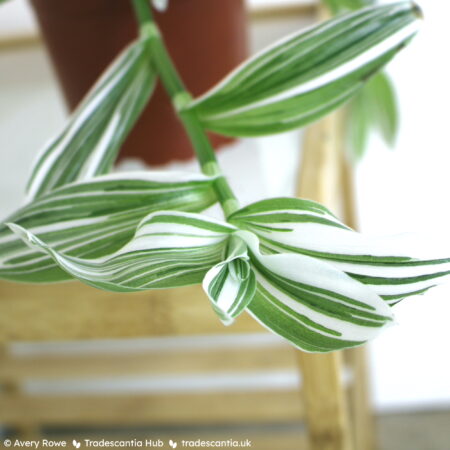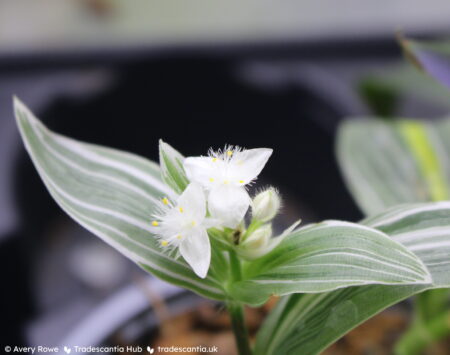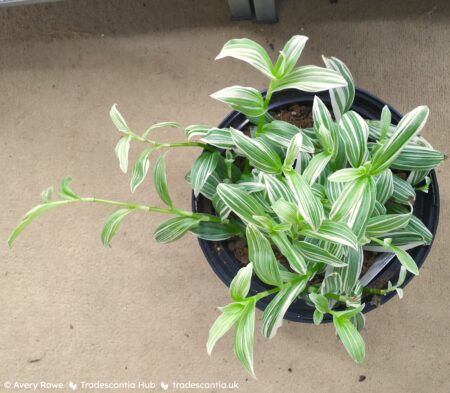Details
| Full name | Tradescantia ‘Albovittata’. |
| Name status | Accepted, the valid name for a unique cultivar. Established with a description by Staff of the L. H. Bailey Hortorium (1976, p. 1119). Although the name in Latin should not be established after 1959 (Brickell et al., 2016, Art 21.11), it has become the most widely-used name and so is now accepted for the cultivar (Brickell et al., 2016, Art. 11.6; Rowe, 2025). Also known as:
Not to be confused with:
|
| Origins | Unknown. |
| Classification | Often labelled as Tradescantia albiflora, which is now considered a botanical synonym for Tradescantia fluminensis (POWO, 2022). It does not fully match that species, but appears to be an unknown hybrid from the subgenus Austrotradescantia. Like other variegated Austrotradescantia cultivars, it is now placed in the Continental Group. |
| Legal protection | None. |
| Availability | Internationally mass-produced, sold under many synonyms and trade names. |
Description
Preserved in a herbarium specimen (“Tradescantia ‘Albovittata'”, 2023).
Described with reference to the RHS Colour Chart (6th Edition; 2019 reprint).
| Cultivar group | Tradescantia Continental Group. |
| Growth habit | Long stems which grow strongly downwards, creeping or trailing out of any container. |
| Foliage | Stems are 2-7mm wide with internodes 1-4cm long, strong yellow green (144A) to moderate olive brown (N199A), smooth except for a line of tiny hairs running along the length. Leaves are narrow pointed ovals, 4-12cm long and 1.5-5cm wide, smooth except for a few long hairs at the top of the sheath, with marginal variegation. On the upper surface, the pale areas are yellowish white (196D) to greenish white (192D), and the dark stripes are greyish olive green (NN137A to NN137C). On the undersides, the pale areas are yellowish white (196D) to very pale green (192C), and the dark areas are greyish yellow green (194A) to pale green (N138C). Leaf sheaths are moderate yellow green (143D) to greyish yellow green (191B). |
| Flowers | 12-15mm across. Petals are pure white. Stamen filaments and pistil are white, anthers are yellow. |
| Comparisons | Compared to ‘TPIWH01-0’, it tends to be smaller and with less bold white areas in the same growing conditions; but the two are generally impossile to distinguish without controlled growing trials. |
References
Staff of the L. H. Bailey Hortorium. (1976). Hortus Third: A Concise Dictionary of Plants Cultivated in the United States and Canada. Macmillan Publishing Co., Inc.
Brickell, C. D., Alexander, C., Cubey, J. J., David, J. C., Hoffman, M. H. A., Leslie, A. C., Malécot, V., Jin, X. (2016). International Code of Nomenclature for Cultivated Plants. PDF link.
Tradescantia ‘Albovittata’. (2023). [Herbarium specimen, barcode WSY0155548]. RHS Wisley Herbarium.
Rowe, A. (2025). Compiling the first Tradescantia cultivar checklist. HortScience, 60(9); 1534-1542. Open access link.




